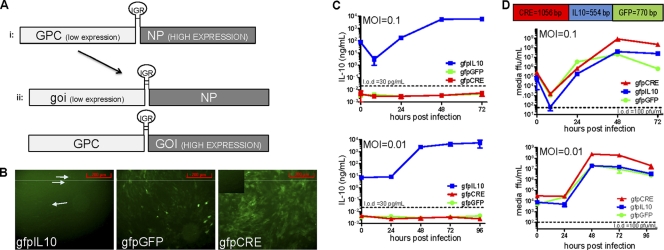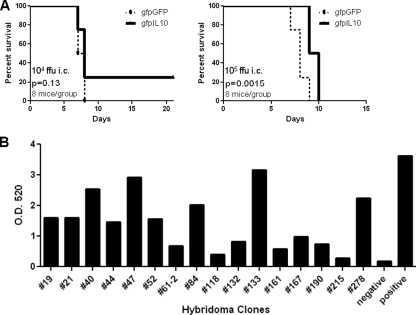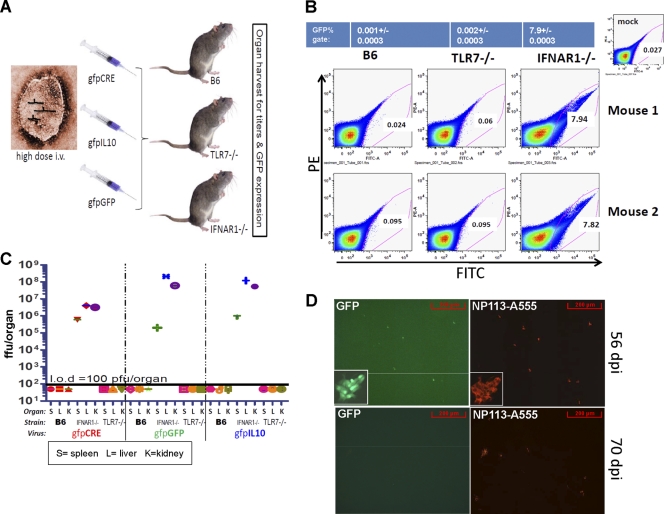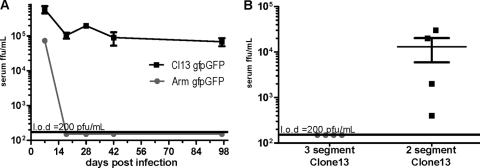Abstract
The recombinant engineering of trisegmented lymphocytic choriomeningitis virus (LCMV) to express two genes of interest was recently reported. We used this technology to efficiently express green fluorescent protein (GFP) and the immunoregulatory gene product interleukin-10 (IL-10) in vitro, assess IL-10 function in vivo during viral meningitis, and generate specific, robust monoclonal antibody responses to IL-10. Tripartite viruses were attenuated in wild-type and TLR7−/− mice. However, IFNAR1−/− mice sustained systemic viral replication when 2 nucleotide substitutions from a persistent LCMV variant were present. These findings demonstrate the utility of tripartite LCMV in vitro and in vivo to study genes in the context of a well-defined model system.
TEXT
Infection of the mouse, the natural host, with the prototypic arenavirus lymphocytic choriomeningitis virus (LCMV) has served as one of the most fruitful models for the investigation of acute and persistent viral infections (5, 15). LCMV is a natural pathogen of rodents which can replicate robustly both in vitro and in vivo. A major boon to the LCMV model is that two similar genetic variants whose biologies are dramatically different can be directly compared. This difference in biological activity between the nonpersistent LCMV Armstrong (Arm) virus and the persistent LCMV clone 13 (Cl13) virus is dependent on only 2 amino acid differences: Arm/Cl13 GP260 (glycoprotein) proteins have Phe/Leu, respectively, and Arm/Cl13 L1079 (polymerase) proteins have Gln/Lys, respectively. Arm is cleared within 1 week by the host, while Cl13 persists several months to potentially the life of the mouse (10, 21). This difference in clearance is inversely correlated with the cytotoxic CD8+ T lymphocyte (CTL) response against these two variants. Therefore, LCMV Arm infection is rapidly cleared in the presence of a robust host CTL response. In contrast, LCMV Cl13 infection is persistent and accompanied by a poorly functional CTL response (reviewed in reference 14).
The development of LCMV reverse genetics (5, 10) has facilitated the generation of recombinant LCM viruses (rLCMV) with predetermined specific mutations and analysis of their phenotypic expression in the context of the natural course of LCMV infection. This has opened new opportunities to investigate arenavirus-host interactions and associated disease. More recently, the use of reverse genetics has led to the generation of trisegmented rLCMV, r3LCMV (in contrast to native bisegmented LCMV) (6). This technology allows one to express non-LCMV genes within the powerful environment of the LCMV model system (5).
Here, we continue to explore the potential of r3LCMV to express and functionally characterize genes of interest in vivo. We rescued viruses expressing the following genes of interest (GOI): the green fluorescent protein (GFP) gene and either the Cre recombinase or the interleukin-10 (IL-10) gene. For this, full-length cDNAs of Cre recombinase, GFP, and IL-10 were inserted into the indicated locus within the S segment of LCMV (Fig. 1A). We obtained cDNA clones for murine IL-10 and Cre recombinase from Mr.Gene. The NCBI accession numbers for the sequences of murine IL-10 and Cre recombinase are NM_0105482 and X0345, respectively. GFP was obtained as described previously (6). We used the following nomenclature convention: lower- or uppercase lettering indicates insertion of the GOI into the GPC (low-expression) or NP (high-expression) locus within the S segment, respectively (6). Ultimately, our goal was to analyze r3LCMV systemically in vivo. Therefore, we incorporated the two nucleotide changes from Cl13 into r3LCMV to favor persistence in mice.
Fig. 1.
r3LCMV allowed for incorporation of a GOI into two different loci enabling either low (GPC locus) or high (NP locus) protein production levels without affecting virus growth in cultured cells. Nomenclature convention: lower-and uppercase lettering indicate insertion into the GPC and NP loci, respectively, i.e., r3LCMVgfpIL10 will provide low-level expression of gfp and high-level expression of IL-10. (A) Depiction of LCMV S segment in bisegmented (i) and trisegmented (ii) viruses. Sites for low and high gene expression levels are shown. The L segment is unchanged between tri- and bisegmented viruses and it is not depicted. (B) GFP expression from (i) the LCMV GPC site, (ii) the LCMV GPC and NP sites, or (iii) the LCMV GPC site and host cell locus. BHK-21 or mouse embryonic fibroblasts (MEF) containing GFP flanked by lox sites (12) were infected with the indicated r3LCMV. At 72 hpi, GFP expression was examined by epifluorescence. Negligible expression was detected from r3LCMVgfpCRE-infected MEF which do not possess reporter loci (inset of rightmost panel). Results for one representative of four independent experiments are shown. (C) r3LCMVgfpIL10-infected cells produce high levels of IL-10. Supernatant was assessed by ELISA for IL-10 at the indicated time points and multiplicities of infection (MOIs). Means ± standard errors of the means (SEM) for 3 independent experiments are shown. The manufacturer's recommendation for the lower limit of detection is shown (Pierce). (D) All three r3LCMVs exhibited similar growth properties in BHK-21 cells. The size of each gene insert is displayed. The limit of detection is depicted with a dashed line. Viral titer means ± SEM are shown for the indicated time points at two MOIs (n=4).
Our initial r3LCMV studies were done with BHK21 cells. We visualized GFP expression by epifluorescence microscopy in cells expressing GFP from either the weaker GPC locus or both GPC and NP loci (Fig. 1A and B). To assess functional Cre recombinase production, we utilized GFP reporter cells which express GFP only after a Cre recombinase-mediated event (12). We observed higher GFP expression levels when utilizing virus containing Cre (Fig. 1B, rightmost panel). In contrast, we detected minimal fluorescence (similar to Fig. 1B, left panel) in cells without GFP reporter loci infected with r3LCMVgfpCRE (inset in Fig. 1B, rightmost panel). This observation was in concert with the known decreased expression in the GPC locus compared to that in the NP locus (reviewed in reference 7).
For IL-10, we observed robust cytokine production from r3LCMVgfpIL10-infected cells as determined in an enzyme-linked immunosorbent assay (ELISA; Pierce) using cell supernatants from multiple conditions (Fig. 1C). Importantly, we did not detect any significant impaired growth in BHK-21 cells for any of the three rLCMV, despite the different lengths of the GOI incorporated into the virus genome (Fig. 1D). Given the extremely high levels of IL-10 produced in r3LCMVgfpIL10-infected cells in culture, we examined the phenotype of this virus in mice. Both cellular IL-10 and viral IL-10 mimetics are induced by many different viruses to counter host inflammatory responses (2, 20). We therefore hypothesized that a virus encoding IL-10 (r3LCMVgfpIL10) might protect mice from lethal meningitis caused by host inflammatory mediators early in LCMV infection (8). Consistent with this hypothesis, we observed significant, though moderate, protection from lethality in mice inoculated intracranially (i.c.) with 105 focus-forming units (FFU) of r3LCMVgfpIL10 compared to that in mice infected with r3LCMVgfpGFP. Survival in days was prolonged by ∼25%, with a P value of 0.0015 (Fig. 2 A). After challenge with 104 FFU of r3LCMVgfpIL10, 6 of 8 mice died, versus r3LCMVgfpGFP challenge, resulting in 8 of 8 deaths (Fig. 2A). We observed similar findings in favor of protection with r3LCMVgfpIL10 after a 103-FFU challenge, although the P value was greater than 0.05 (data not shown). The protection afforded by IL-10 is likely due to a decrease in immunopathology. There are several instances where IL-10 might interrupt an otherwise fatal meningitis, including at the level of blocking CTL activity as well as innate effectors such as macrophages and neutrophils (reviewed in reference 13).
Fig. 2.
In vivo utility of r3LCMV expressing IL-10. (A) LCMV-mediated expression of IL-10 confers partial protection against LCMV-induced fatal meningitis. C57BL/6 mice were inoculated i.c. with the indicated r3LCMV and doses. Kaplan-Meier survival analysis is shown. (B) r3LCMVgfpIL10 elicits a potent plasma cell response. IL-10−/− mice were primed and boosted with 106 FFU of ilIL10 on days 0, 30, 60, and 90. Splenocytes were fused with a myeloma cell line as described previously (3) and assessed for IL-10-specific binding by an ELISA where recombinant IL-10 (Peprotech) was plate bound, followed by addition of hybridoma supernatant. Sixteen clones displaying IL-10-specific binding above the background are shown. BD clone JES5-2A5 was used at 1 μg/ml as a positive control. Supernatant from uninfected IL-10−/− hybridomas was used as a negative control. O.D. 520, optical density at 520 nm.
These observations support the potential of using r3LCMV to determine the biological effects of candidate immune molecules, and other host genes, during the natural course of LCMV infection in vivo.
Next, we tested whether r3LCMVgfpIL10 could efficiently immunize mice for IL-10-specific hybridoma production. For this, we immunized IL-10-deficient (IL-10−/−) mice as described previously (3) to produce plasmacytes with high avidity for IL-10. We obtained a large number of highly productive hybridomas from immunized mice after a single immunization (data not shown). We then continued to boost mice according to an established protocol (3) in order to obtain several high-affinity clones specific to IL-10 to use for in vivo depletion (Fig. 2B). Thus, trisegmented LCMV can be used to generate antibodies against various genes of interest, using the viral infection as a natural adjuvant. Since virus replicates to produce millions of progeny greater than the numbers originally inoculated, this procedure is likely to be more efficient than immunization protocols based on a nonreplicating adjuvant. Further, LCMV preferentially infects dendritic cells and macrophages (17–19), which facilitates the transport of the immunogen to professional antigen-presenting cells (9), thereby enhancing the resultant immune response.
Next, we examined the replication of r3LCMV in mice after high-dose intravenous (i.v.) challenge. In contrast to the systemic persistence observed after similar challenge with the bisegmented Cl13 virus (1), r3LCMV containing gfp and either cre, a second gfp locus, or il10 did not persistent in either wild-type C57BL/6 mice or the immunocompromised TLR7−/− mouse (4) (Fig. 3 A to C) (all mice were maintained in the closed breeding colony of The Scripps Research Institute, backcrossed >12 generations on C57BL/6 mice from Jackson Laboratories), which is more susceptible to LCMV infection (data not shown). However, in mice insensitive to type I interferon (IFNAR1−/− mice) (11), we detected high levels of r3LCMV in spleen, liver, kidney, and serum samples. Furthermore, functional expression of GFP was readily observed in infectious virus recovered from the sera for at least 56 days postinfection (dpi) by immunofluorescence (Fig. 3A to D). Titers at this time point (56 dpi) were at 1 × 105 to 3 × 105 FFU/ml.
Fig. 3.
Three-segment viruses are attenuated in vivo but can persist in type I interferon unresponsive mice. (A) Experimental design outlining the three r3LCMV used to infect three different mouse strains. (B) Detection of GFP in vivo only in IFNAR1−/− mice. Mice were inoculated (i.v.) with 2 × 107 FFU of r3LCMVgfpIL10. Splenocytes were harvested at 5 dpi and analyzed by flow cytometry. Cellular fluorescence was assessed on two channels to isolate GFP expression above the background autofluorescence level. Results for r3LCMVgfpGFP in 3 strains of mice, C57BL/6, TLR7−/−, and IFNAR1−/−, are shown. The percentage of GFP+ cells is shown in the magenta gate. Mean percentages of GFP+ gated cells ± SEM for 3 independent experiments are shown. Results are shown for a representative of three independent experiments. (C) r3LCMV replicate to high levels in IFNAR1−/− mice. Mice were inoculated with 2 × 107 FFU of three-segmented LCMV i.v. as described for panel A. At 4 dpi, spleen, liver, and kidney were harvested for viral titers. Means ± SEM are shown for 1 of 2 similar experiments, with 3 mice/condition. (D) Functional GFP is expressed up to 56 days in vivo. Immunofluorescent images are shown for Vero cells inoculated with sera from IFNAR1−/− mice infected with gfpGFP LCMV at the indicated time points postinfection. Endogenous GFP expression is shown natively in green. Staining with the NP113 monoclonal specific to LCMV NP is shown in red secondary to Alexa Fluor 555 conjugation. We observed no staining with the isotype control antibody 13-4013. Similar results were seen between days 5 and 56. Results for one of four similar experiments are shown.
Given that trisegmented viruses persist in the absence of a type I interferon response, we assessed the fidelity of this persistence with respect to the differences between the persistent LCMV Cl13 virus versus the acutely controlled LCMV Arm virus (in native bisegmented LCMV). To this point, we compared gfpGFP viruses which differed by only two amino acids, with “Cl13 gfpGFP” bearing a nucleotide sequence identical to that of “Arm gfpGFP” except for 2 nucleotide changes resulting in F260L and K1076Q substitutions in the GP and L genes, respectively. We then assessed whether the same key substitutions in the bisegmented virus would have a similar effect for the trisegmented virus. As with the native LCMV model system, these 2 nucleotide changes determined whether the infection was acute or persistent (Fig. 4A). Unexpectedly, these mutations conferred an even more profound difference in viremia curves in the trisegmented than in the bisegmented system (16).
Fig. 4.
r3LCMVs are displaced by 2-segment viruses and require mutations from a persistent variant of LCMV, clone 13, to persist in IFNAR1−/− mice. (A) Three-segment LCMV requires the glycoprotein (GP) and polymerase (L) substitutions of clone 13 to persist in IFNAR1−/− animals. IFNAR1−/− mice were inoculated with the indicated tripartite virus bearing the GP and L amino acid variants from the acute LCMV Armstrong53b strain or the persistent LCMV clone 13 strain (as described by Sullivan et al. [21]). Mice were bled at the indicated time points postinfection to assess for viremia. Means ± SEM are shown for 7 animals per group as indicated prior to termination of the time course at 96 dpi. (B) Tripartite LCMV does not persist in the presence of bisegmented LCMV. IFNAR1−/− mice were infected with 2 × 107 FFU of gfpIL10 i.v. At 9 days postinfection, mice were challenged with 2 × 105 PFU bisegmented LCMV clone 13 i.v. and subsequently bled at 2 days postchallenge to quantitate viremia in bisegmented virus versus that in trisegmented virus. Similar results were observed with both r3LCMV gfpGFP and r3LCMV gfpIL10. Means ± SEM are shown for 4 mice. Results for 1 of 2 similar experiments are shown.
Finally, we assessed the fitness relationship between tri- and bisegmented viruses in vivo. In order to determine this, we set up an in vivo competition assay. IFNAR1−/− mice were infected with a high dose (2 × 107 FFU i.v.) of r3LCMVCl.13gfpGFP. Nine days after the initial r3LCMV infection, mice were challenged with a low dose of bisegmented LCMV Cl13 (2 × 105 FFU i.v.). After challenge with bisegmented LCMV Cl13, we were unable to detect fluorescent tripartite virus in sera. We observed similar results with r3LCMVCl.13gfpIL10 (Fig. 4B). Therefore, tripartite LCMV is rapidly displaced by bisegmented LCMV in vivo. This additional degree of attenuation may facilitate the biosafety of r3LCMV as a platform to express genes of interest in vivo.
In summary, we have presented evidence for the utility of the r3LCMV platform for diverse applications, including in vitro protein production, in vivo antibody production, assessment gene function in vivo, and analysis of viral persistence. We measured high and sustained production of unconcentrated IL-10 in the supernatant of r3LCMV infected cells (as well as efficient viral production of Cre recombinase and enhanced GFP [eGFP]). We then showed that r3LCMV can also be used to elicit a superb antibody response. Next, we found an effect of our gene of interest in a convenient model of meningitis. Finally, we observed a profound difference in persistence due to only 2 substitutions in r3LCMV. This difference was greater than what is observed for bisegmented LCMV and takes place in an immunocompromised model where the investigator can easily exchange 2 distinct genes of interest which can maintain stable expression for at least 2 months. These new possibilities further enhance the power of LCMV infection of the mouse as a superb model for studying both acute and persistent viral infection and associated disease.
ACKNOWLEDGMENTS
This is publication 21143 from the Departments of Immunology and Microbial Science, The Scripps Research Institute, La Jolla, CA.
Our work was supported by the following National Institutes of Health grants: AI047140 (to S.E. and J.C.D.L.T), AI09484 and AI70967 (to M.O.), and training grant AI007244 (to D.L.P.).
Footnotes
Published ahead of print on 25 May 2011.
REFERENCES
- 1. Ahmed R., Oldstone M. 1988. Organ-specific selection of viral variants during chronic infection. J. Exp. Med. 167:1719–1724 [DOI] [PMC free article] [PubMed] [Google Scholar]
- 2. Brooks D. G., et al. 2006. Interleukin-10 determines viral clearance or persistence in vivo. Nat. Med. 12:1301–1309 [DOI] [PMC free article] [PubMed] [Google Scholar]
- 3. Buchmeier M. J., Lewicki H. A., Tomori O., Oldstone M. B. 1981. Monoclonal antibodies to lymphocytic choriomeningitis and pichinde viruses: generation, characterization, and cross-reactivity with other arenaviruses. Virology 113:73–85 [DOI] [PubMed] [Google Scholar]
- 4. Christensen S. R., et al. 2006. Toll-like receptor 7 and TLR9 dictate autoantibody specificity and have opposing inflammatory and regulatory roles in a murine model of lupus. Immunity 25:417–428 [DOI] [PubMed] [Google Scholar]
- 5. de la Torre J. C. 2009. Molecular and cell biology of the prototypic arenavirus LCMV: implications for understanding and combating hemorrhagic fever arenaviruses. Ann. N. Y. Acad. Sci. 1171(Suppl. 1):E57–E64 [DOI] [PubMed] [Google Scholar]
- 6. Emonet S., Garidou L., McGavern D., de la Torre J. 2009. Generation of recombinant lymphocytic choriomeningitis viruses with trisegmented genomes stably expressing two additional genes of interest. Proc. Natl. Acad. Sci. U. S. A. 106:3473–3478 [DOI] [PMC free article] [PubMed] [Google Scholar]
- 7. Emonet S. E., Urata S., de la Torre J. C. 2011. Arenavirus reverse genetics: new approaches for the investigation of arenavirus biology and development of antiviral strategies. Virology 411:416–425 [DOI] [PMC free article] [PubMed] [Google Scholar]
- 8. Kang S. S., McGavern D. B. 2008. Lymphocytic choriomeningitis infection of the central nervous system. Front. Biosci. 13:4529–4543 [DOI] [PMC free article] [PubMed] [Google Scholar]
- 9. Mellman I., Turley S. J., Steinman R. M. 1998. Antigen processing for amateurs and professionals. Trends Cell Biol. 8:231–237 [DOI] [PubMed] [Google Scholar]
- 10. Moskophidis D., et al. 1995. Role of virus and host variables in virus persistence or immunopathological disease caused by a non-cytolytic virus. J. Gen. Virol. 76(Pt. 2):381–391 [DOI] [PubMed] [Google Scholar]
- 11. Muller U., et al. 1994. Functional-role of type-I and type-Ii interferons in antiviral defense. Science 264:1918–1921 [DOI] [PubMed] [Google Scholar]
- 12. Novak A., Guo C., Yang W., Nagy A., Lobe C. G. 2000. Z/EG, a double reporter mouse line that expresses enhanced green fluorescent protein upon Cre-mediated excision. Genesis 28:147–155 [PubMed] [Google Scholar]
- 13. O'Garra A., Barrat F. J., Castro A. G., Vicari A., Hawrylowicz C. 2008. Strategies for use of IL-10 or its antagonists in human disease. Immunol. Rev. 223:114–131 [DOI] [PubMed] [Google Scholar]
- 14. Oldstone M. 2006. Viral persistence: parameters, mechanisms and future predictions. Virology 344:111–118 [DOI] [PubMed] [Google Scholar]
- 15. Oldstone M. B. 2007. A suspenseful game of ‘hide and seek’ between virus and host. Nat. Immunol. 8:325–327 [DOI] [PubMed] [Google Scholar]
- 16. Popkin D. L., et al. 2011. Hypomorphic mutation in the site-1 protease Mbtps1 endows resistance to persistent viral infection in a cell-specific manner. Cell Host Microbe 9:212–222 [DOI] [PMC free article] [PubMed] [Google Scholar]
- 17. Sevilla N., et al. 2000. Immunosuppression and resultant viral persistence by specific viral targeting of dendritic cells. J. Exp. Med. 192:1249–1260 [DOI] [PMC free article] [PubMed] [Google Scholar]
- 18. Sevilla N., Kunz S., McGavern D., Oldstone M. 2003. Infection of dendritic cells by lymphocytic choriomeningitis virus. Curr. Top. Microbiol. Immunol. 276:125–144 [DOI] [PMC free article] [PubMed] [Google Scholar]
- 19. Sevilla N., McGavern D., Teng C., Kunz S., Oldstone M. 2004. Viral targeting of hematopoietic progenitors and inhibition of DC maturation as a dual strategy for immune subversion. J. Clin. Invest. 113:737–745 [DOI] [PMC free article] [PubMed] [Google Scholar]
- 20. Slobedman B., Barry P. A., Spencer J. V., Avdic S., Abendroth A. 2009. Virus-encoded homologs of cellular interleukin-10 and their control of host immune function. J. Virol. 83:9618–9629 [DOI] [PMC free article] [PubMed] [Google Scholar]
- 21. Sullivan B. M., et al. 2011. Point mutation in the glycoprotein of lymphocytic choriomeningitis virus is necessary for receptor binding, dendritic cell infection, and long-term persistence. Proc. Natl. Acad. Sci. U. S. A. 108:2969–2974 [DOI] [PMC free article] [PubMed] [Google Scholar]






